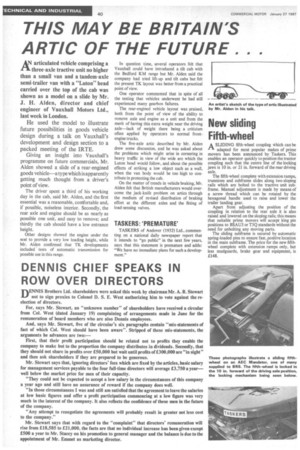THIS MAY BE BRITAIN'S ARTIC OF THE FUTURE . .
Page 42

If you've noticed an error in this article please click here to report it so we can fix it.
Narticulated vehicle comprising a three-axle tractive unit no higher than a small van and a tandem-axle semi-trailer van with a "Luton" head carried over the top of the cab was shown as a model on a slide by Mr. J. H. Alden, director and chief engineer of Vauxhall Motors Ltd., last week in London.
He used the model to illustrate future possibilities in goods vehicle design during a talk on Vauxhall's development and design section to a packed meeting of the IRTE. Giving an insight into Vauxhall's programme on future commercials, Mr. Alden showed a slide of a rear-engined goods vehicle—a type which is apparently getting much thought from a driver's point of view.
The driver spent a third of his working day in the cab, said Mr. Alden, and the first essential was a reasonable, comfortable and, if possible, noiseless interior. Secondly, the rear axle and engine should be as nearly as possible one unit, and easy to remove; and thirdly the cab should have a low entrance height.
Other designs showed the engine under the seat to provide a very low loading height. while Mr. Alden confirmed that TK developments included tests of automatic transmission for possible use in this range. In question time, several operators felt that Vauxhall could have introduced a tilt cab with the Bedford KM range but Mr. Alden said the company had tried lift-up and tilt cabs but felt the present TK layout was better from a practical point of view.
One operator commented that in spite of all the testing that vehicles underwent he had still experienced many gearbox failures.
The rear-engined vehicle layout was praised, both from the point of view of the ability to remove axle and engine as a unit and from the merit of having this extra weight near the driving axle—lack of weight there being a criticism often applied by operators to normal frontengine trucks.
The five-axle attic described by Mr. Alden drew some discussion, and he was asked about the problems which might arise in cornering in heavy traffic in view of the wide arc which the Luton head would follow, and about the possible effects of striking a low object such as a wall, when the van body would be too high to contribute in protecting the cab.
On the matter of trends in vehicle braking, Mr. Alden felt that British manufacturers would overcome the jack-knife problem on attics through the medium of revised distribution of braking effort at the different axles and the fitting of load-sensing valves.
TASKERS: 'PREMATURE'
TASKERS of Andover (1932) Ltd., commenting on a national daily newspaper report that it intends to "go public" in the next few years, says that this statement is premature and adds: "We have no immediate plans for such a development."












































































































